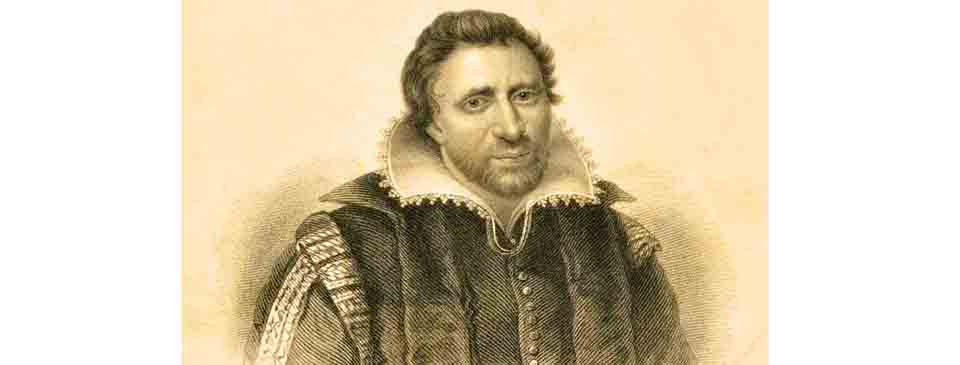Ben Jonson

This is one of numerous images of Ben Jonson, most of which are derived from the contemporary portrait by Abraham van Blyenberch that today hangs in the National Portrait Gallery. He was said to have one eye lower than the other.
Jonson’s favour at court did not protect him from difficulties with the authorities. Sejanus, His Fall in 1603 or early 1604, with Shakespeare in the leading role, saw him called before the Privy Council on charges of “popery and treason”. The following year he worked with two others on Eastward Ho!, which led to the imprisonment of his collaborators and Jonson voluntarily joining them.
Even more serious, on his release from prison Jonson dined with a number of the leading conspirators in the Gunpowder Plot on the eve of its execution in November 1605 and could well have known of their plans. He subsequently distanced himself from the assassination attempt by offering to help with the Earl of Salisbury’s investigations.
Several times in the following year Jonson and his wife appeared before the consistory court for failing to attend Anglican church services. (His allegiance to either the Catholic or Anglican Churches seem to be ambiguous from 1610 onwards). Amid these problems, Jonson’s comic masterpiece, Volpone, was first performed by the King’s Men at the Globe theatre in March 1606. Epicene of 1612, was praised for its structural complexity but was banned following a complaint from the King’s cousin.
In the summer of 1612 Jonson was employed as tutor to the young Walter Raleigh, son of the more famous explorer of the same name. The two took an excursion to France and the Low Countries but much drunkenness ensued. (Young Walter later died accompanying his father while on a mission to discover the legendary El Dorado).
By June 1613 Jonson was back in London where he witnessed the fire that destroyed the original Globe theatre at Southwark. The last of Jonson’s great comedies, Bartholomew Fair, was premiered by Lady Elizabeth’s Men at the new Hope theatre in 1614.
Until the early 17th century playwrights had little interest in publishing their plays, partly because the script was owned by the theatre company and the copyright in the published version by the printer rather than the writer. Theatrical scripts were anyway not considered a meaningful form of literature. Despite those difficulties, in 1616 Jonson arranged for the publication of a folio collection of nine of his plays, together with masques, poems and other works. It led the way to the printing seven years later of the posthumous publication of Mr. William Shakespeare’s Comedies, Histories and Tragedies, containing 36 of the Bard’s plays and now known as the ‘First Folio’. The death of Shakespeare in the same year as the publication of Jonson’s Workes folio ensured that Jonson was by then considered England’s greatest living author, with an annual pension of 100 marks from the King.
At the age of 45 in 1618, and at the height of his fame, Jonson decided to walk to his father’s (and King James’s) homeland of Scotland. John Taylor, the Thames Watermen’s poet took a simultaneous journey by a different route and the two writers met in Leith.
After his return Jonson lectured (and perhaps lived) at Gresham College, received an honorary Master of Arts degree from Oxford University, and became the leading light among a group of writers who met in London. In 1628 he was appointed City Chronicler of London, a task he carried out with great inefficiency, leading to a suspension of payments. In the same year he suffered a severe stroke but lived on in poor health, helped by his friends, and with some financial support and a supply of wine from King Charles. Isaak Walton witnessed and wrote of Jonson’s affection for the drink. Nevertheless, he continued to produce an annual masque – the last with Inigo Jones in 1631, by which time relations had soured – and other works for the King. His final theatrical play was performed at Blackfriars in 1632.
Jonson died in 1637 and his funeral at Westminster Abbey was well-attended. It was his wish to be buried there but he did not have sufficient funds for a normal grave. Instead he agreed with the Abbey that he be given enough space to be buried upright. The slab above his body was inscribed “O Rare Ben Johnson!” (sic). His memory and work continued to live on, with two further folios of his writing published in 1640 and 1692.
Sources include: Oxford Dictionary of National Biography.
< Back to London People


